






FRED THOMPSON
It is hard to believe that “The Season” is coming to an end already! But it must be true based on the number of bins at the street on trash day and the RVs heading north on I 75 in the morning! We hope that the snowbirds have enjoyed their winter in paradise as the weather, other than that week in January, has been wonderful! Unfortunately, the dry days have left us with a drought and a concern for brush fires. But we will try to protect your residences while you are gone.
At the February Master board meeting we approved transferring our access control contract from Statewide Services to St. Moritz Services. They will provide access control at our gate and the roving patrol. Access Control is the second most expensive contract for the Master Association at about $450K/year but one that Mike Patricelli, our Master Association Access Control Director, watches closely because of the importance of these services for our resident and non-residence owners. Mike’s discussions with several local highend developments found universal high ratings for St. Moritz and its employees. A wave to their roving patrol is always appreciated. Speaking of waves, I am pleased to see friendly
(what I call Midwest) waves to walkers and bikers. Whether you recognize them or not, waves say “hi” and “glad to see you!”
Our Treasurer, Mickey Wheeler presented the final 2024 fiscal statement for discussion and approval. The statement discloses that we essentially met our budget with a $10K deficit on revenues of $2.4 million. The budget augmented revenues with a transfer of $90K from our Retained Earnings to allow us to hold our

assessment stable for 2024 and give our neighborhoods an opportunity to refresh their restoration reserves after recent hurricane damages. The 2025 budget includes $50K to return our Master restoration reserve to about $100K. Your Master Board continues our policy of providing enough reserves to avoid special assessments for “moderate” hurricane damage.
I assume that everyone has completed and filed their tax returns. With the cutbacks on IRS staffing, I wonder what will happen to refund processing?
Will they ever consider repealing the tax code and asking everyone to just send a check for the value of the services they received from the government? Think of the time that would save!
About that noise and smoke from the Miromar land on our northern border, we recently observed the site from a resident’s drone. What we saw is a large land area that stretches from the southern border of FGCU down to the narrow parcel Lee County purchased on the Grandezza northern border. The parcel is in unincorporated Lee County and not subject to Estero controls. This site was the subject of a zoning dispute between Grandezza and

Miromar several years ago. At that time, your Master Association arranged to have about 100 Grandezza residents attend the county hearing to express our concerns about the closeness of the small shopping center and possible student noise interfering with our Cypress Cove residents. We negotiated restrictions for setbacks and noise for the commercial buildings and setbacks for any residential buildings east of the student housing. At that time, our concern was further multi-story student housing. While apparently no subsequent development plans have been filed with the

county, Miromar received approval for clearing the land for roads and underground utilities but not to install such improvements. Our agreement with Miromar limits building heights and other restrictions to keep the buildings closest to our borders at lower heights. While the land clearing area does not disclose the type of structures planned, it appears that they are considering private residential structures and have removed scrub vegetation to reduce the risk of brush fires close to our border and their buildings. In general, we feel that Miromar has created a quality residential community and whatever they may put there will be compatible with their (and our) community. We will continue to watch for any county actions.
At the end of February, the Grandezza United Way Committee completed their 2024-25 fund drive. Once again, they reached their goal of $215K which brings the total raised since 2009 to $1,968K!! Congratulations to the Committee for their efforts under the leadership of Bill and Pat Motzer!
All for now! We hope all have safe trips north for “migration” and vacations and look forward to your return while we can now again enjoy our roads and restaurants!









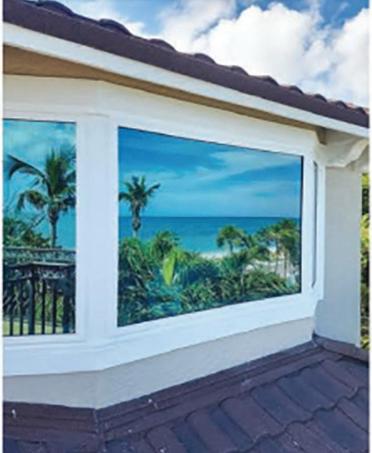








SUSAN SHERWIN
April’s celebrations range from religious observances and environmental initiatives to lighthearted traditions and civic responsibilities. Let’s take a look at some of them.

APRIL FOOLS’ DAY (APRIL 1)
April begins with April Fools’ Day, a fun tradition where people play harmless (hopefully) practical jokes
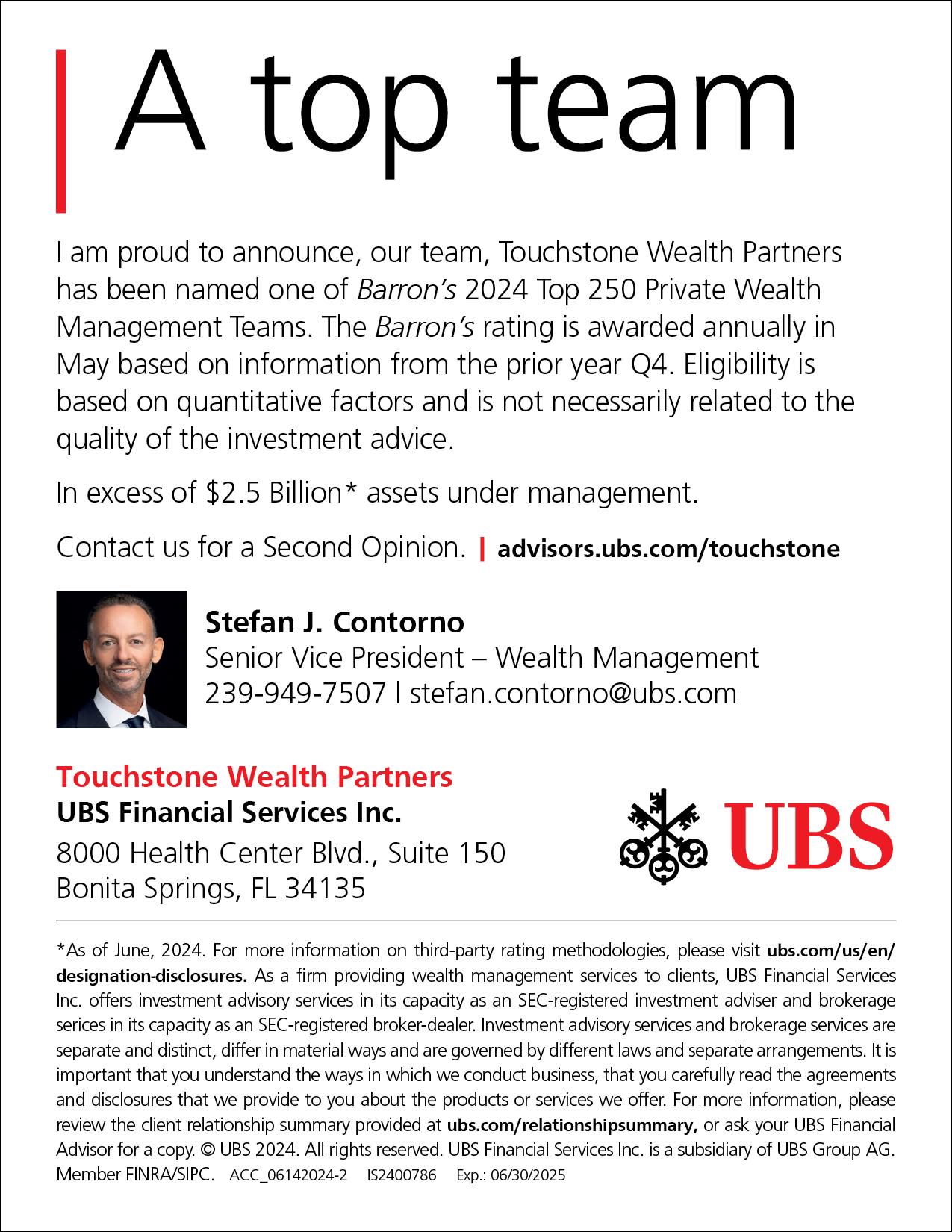
on one another. Though its exact origins are uncertain, some historians believe it dates back to 16th-century France, when the country adopted the Gregorian calendar. Those who continued celebrating the new year in April, as per the old Julian calendar, were mocked as “April fools.”
PASSOVER (APRIL 12 TO 20)
One of the most significant Jewish holidays, Passover celebrates the liberation of the Israelites from slavery in Egypt . Observed for seven or eight days, Passover is marked by the Seder , a special meal on the first and often second night of the holiday. Symbolic foods such as matzah (unleavened bread) are served and represent the haste of the Israelites’ escape. The holiday emphasizes themes of freedom and perseverance.


TAX DAY (APRIL 15)
Though not a “holiday” in the traditional sense, Tax Day or April 15 is the deadline for individuals to file their federal income tax returns. While many taxpayers anticipate refunds, others scramble to meet the deadline or file for extensions. Taxes play a crucial role in funding government programs, infrastructure, and public services, making Tax Day an important civic responsibility.

(APRIL 20)
For Christians, Easter is a major religious celebration honoring the resurrection of Jesus Christ. It is preceded by Good Friday, which commemorates his crucifixion. Easter traditions include church services, festive meals, and Easter egg hunts, with eggs symbolizing new life. While Easter is deeply spiritual, many of its customs, such as the Easter Bunny (think chocolate), have roots in ancient springtime fertility traditions, making it a holiday celebrated in both religious and secular ways.

One of the most globally recognized April events is Earth Day, dedicated to environmental awareness and action. First celebrated in 1970, Earth Day raises awareness of issues like climate change, pollution, and deforestation. People worldwide participate in activities such as tree-planting, cleanup efforts, and sustainability initiatives. Governments and organizations also use this day to push for eco-friendly policies,

highlighting the need for global cooperation to protect our planet.
Closely related to Earth Day, Arbor Day encourages the planting and conservation of trees. Originating in Nebraska in 1872, the holiday emphasizes the importance of trees in maintaining ecological balance, combating climate change, and improving air quality. Schools, businesses, and environmental groups organize tree-planting events, fostering a sense of responsibility toward nature.


April is a month of diverse traditions, faith, and global awareness. From the playfulness of April Fools’ Day to the spiritual depth of Passover and Easter, from the civic responsibility of Tax Day to the environmental advocacy of Earth Day and Arbor Day, each event carries unique meaning. These celebrations remind us of our shared histories, cultural values, and responsibilities— whether to our faith, our communities, or this planet we call home.
Happy April, Grandezza!


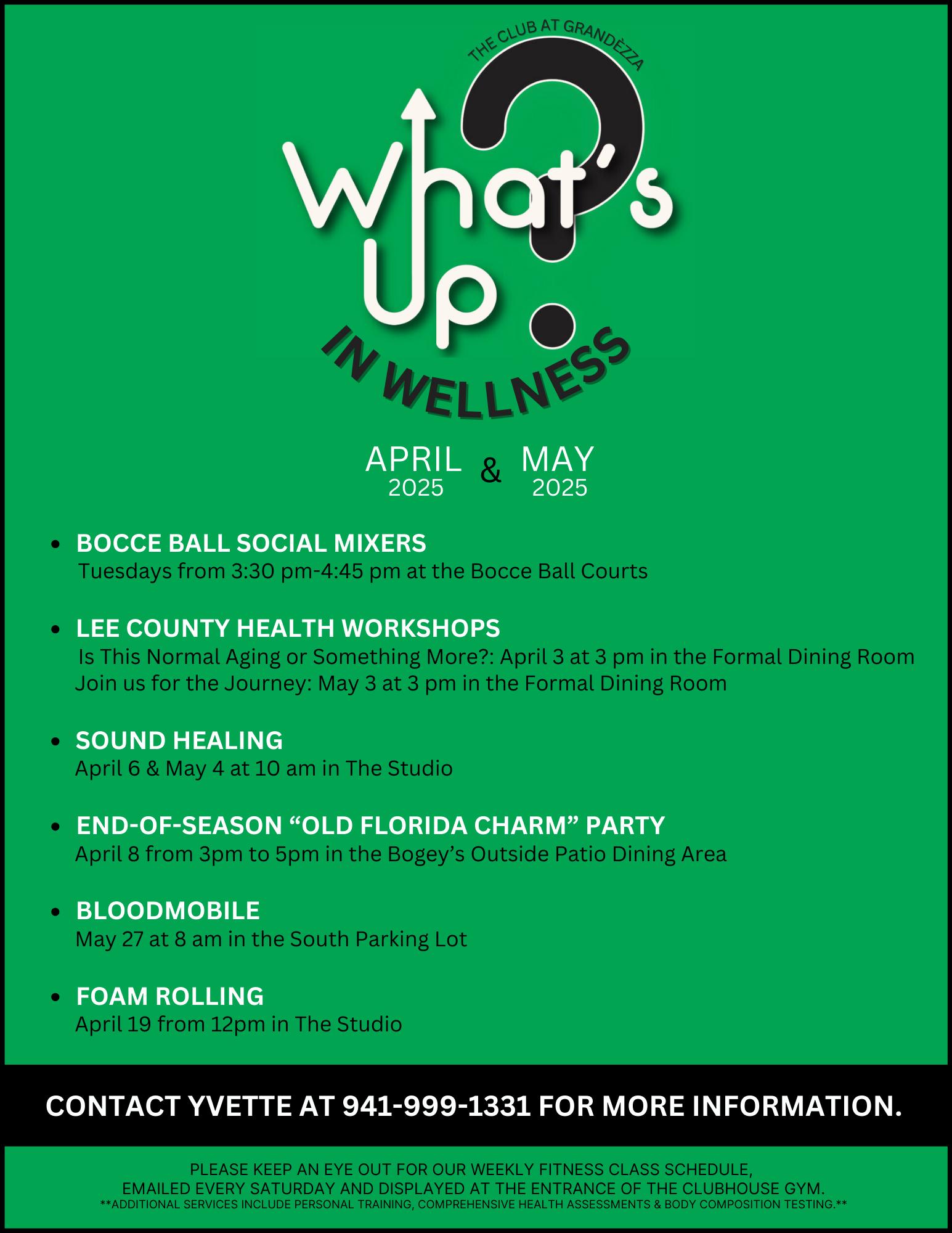

YVETTE BERNOSKY, B.MS., DIRECTOR OF FITNESS & WELLNESS, THE CLUB AT GRANDÉZZA
As life events have struck my heart, Dr. Gabor Mate’s five levels of compassion have helped me understand the deep compassion I feel for humanity.
In the wake of recent tragedies, I can’t help but feel compassionate for the people in California who lost everything in the fires, the people in North Carolina who lost everything due to the hurricane and the lives that were lost in other unfortunate disasters. I think about the devastation and feel their pain. If anyone reading this has been affected, my heart sincerely goes out to you. This is the type of compassion that most of us share as we care for humanity, and we suffer alongside each other.
I can’ t imagine having a home where I feel safe and secure and in the blink of an eye, it ’s gone. Or losing a loved one in a horrific tragedy. Just think of how these events have affected so many people nationwide. Putting yourself in another person’s shoes, you can try to comprehend what they are going through.
When tragedies like this happen, no one is immune. It doesn’t matter your background, gender, status or nationality. These unfortunate circumstances can happen to anyone at any time. In times like these, people from all walks of life unite to help each other. We drop judgment, knowing we are no different. We all cry the same tears and when we embrace our differences, we are all one.


There is no sugar-coating these traumas. They are real. They will take time to process and get through, and the imprint upon us may last a lifetime. We may live our lives differently moving forward and we need to accept our realities as it is necessary to heal.
Each of us will move forward, and life will begin again. It may not feel like it when we are in the middle of a difficult time, but people are resilient. Inside each of us is a beautiful spirit that seeks to rise and overcome our challenges. Often, we find a strength we didn’ t even know we had and look to the future, even in the darkest hours.

I reflect on my life at the moments when the floor fell out from underneath my feet and I am so grateful for the people who shared deep compassion for me. These people lifted my spirit when I could not lift my own. May you always see with the eye of your heart and have the kindness to share it.
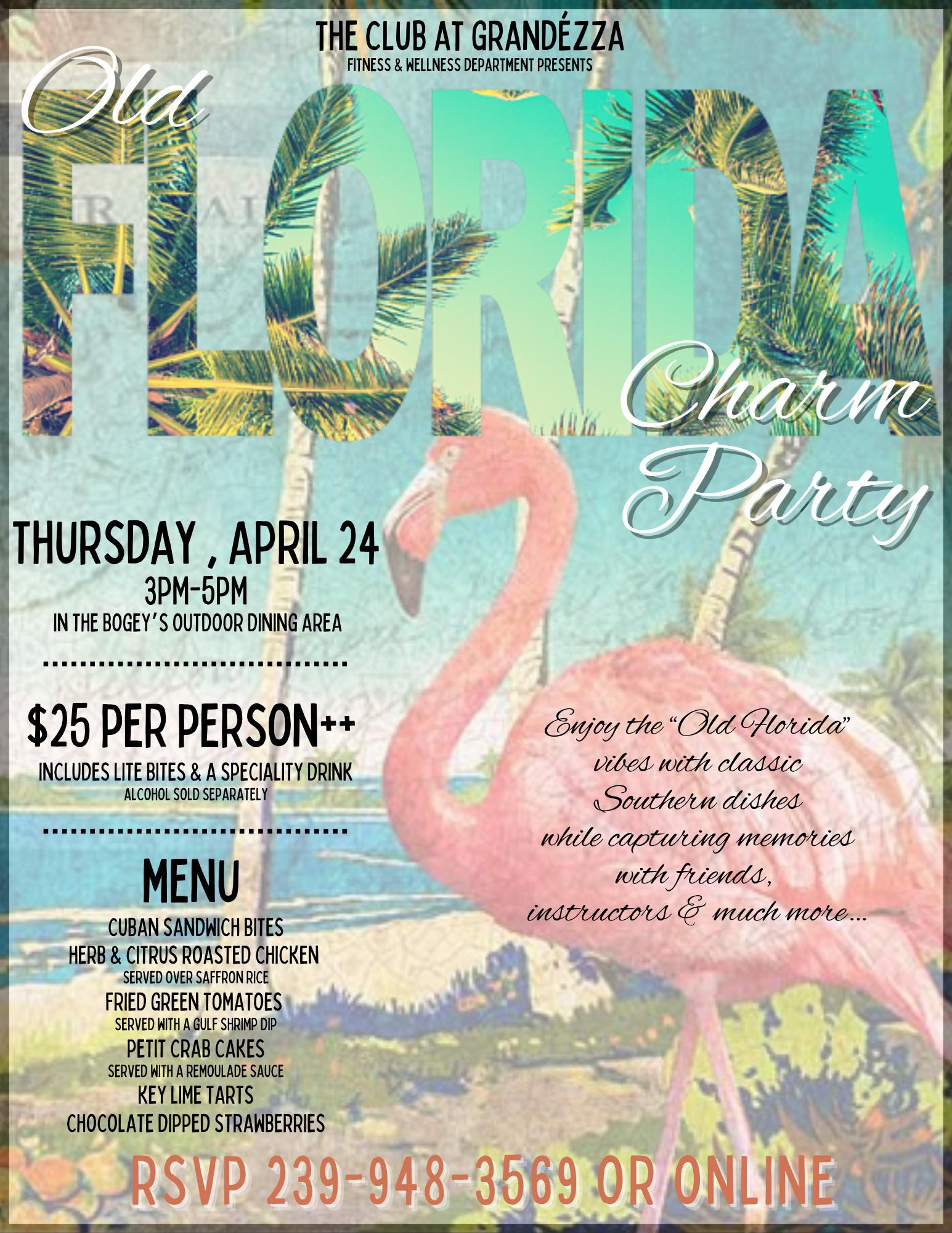

DAVID DEKEERSMAKER, DIRECTOR OF TENNIS THE CLUB AT GRANDÉZZA
One of the most overlooked yet essential elements of a strong tennis game is shoulder rotation. Whether you’re hitting a forehand, backhand, or serve, proper shoulder movement is the key to unlocking effortless power, improved accuracy, and a fluid stroke.
Simply put, shoulder rotation refers to the turning of your upper body during a stroke.
This movement allows you to store energy on the backswing and then release it efficiently through the ball. Without proper rotation, your shots rely too much on your arm, leading to inconsistent contact and potential injuries.


1. Forehand: Start by turning your shoulders sideways as you prepare to hit. This coiling action stores energy. As you swing forward, let your shoulders uncoil naturally leading the racket through the ball.
2. Backhand (One-handed and Twohanded): The backhand requires full shoulder turn to generate power. For a one-handed backhand, think about rotating your hitting shoulder under your chin. For a two-handed backhand, both shoulders should turn as if preparing to hit a left-handed forehand (for right-handed players).
3. Serve: Shoulder rotation is crucial in the serve. As you toss, coil your shoulders to create separation between your lower and upper body. When you uncoil, your shoulders help generate racquet head speed, adding power to your serve without excessive effort.
• More Power – By engaging your torso you reduce reliance on your arm and gain effortless racquet acceleration.
• Better Control – A fluid rotation keeps your stroke compact and repeatable, leading to more precise ball striking and placement.
• Reduced Injury Risk – Without proper rotation your arm and wrist take on
unnecessary strain, increasing the risk of tennis elbow and shoulder injuries.
• Improved Court Coverage – Rotation isn’t just for hitting. Proper shoulder engagement also helps with balance and movement, allowing you to recover quickly after shots.
The next time you are on the court, focus on turning your shoulders early and letting them drive your stroke.
See you on the courts!



MEI-MEI CHAN KIRK
I must confess: Not that long ago, I was not all that interested in visiting Antarctica.
Ice and penguins and 7th continent bragging rights. Uh huh. What’s all the fuss?
Antarctica captured my heart and I already long to return.
My adult daughter, Regan, and I were among 365 guests aboard Viking’s Octantis to the Falklands, South Georgia and Antarctica, embarking Dec. 16, 2024.
I’ve been on a Viking ocean cruise and loved the luxurious pampering. For an expedition, Viking wasn’t our first choice due to its size (400 passengers vs. 200 on other ships) but this itinerary included the Falklands and South Georgia and fit within Regan’s schedule.
We worried we wouldn’t get to kayak, wouldn’t see whales, wouldn’t get on land much,
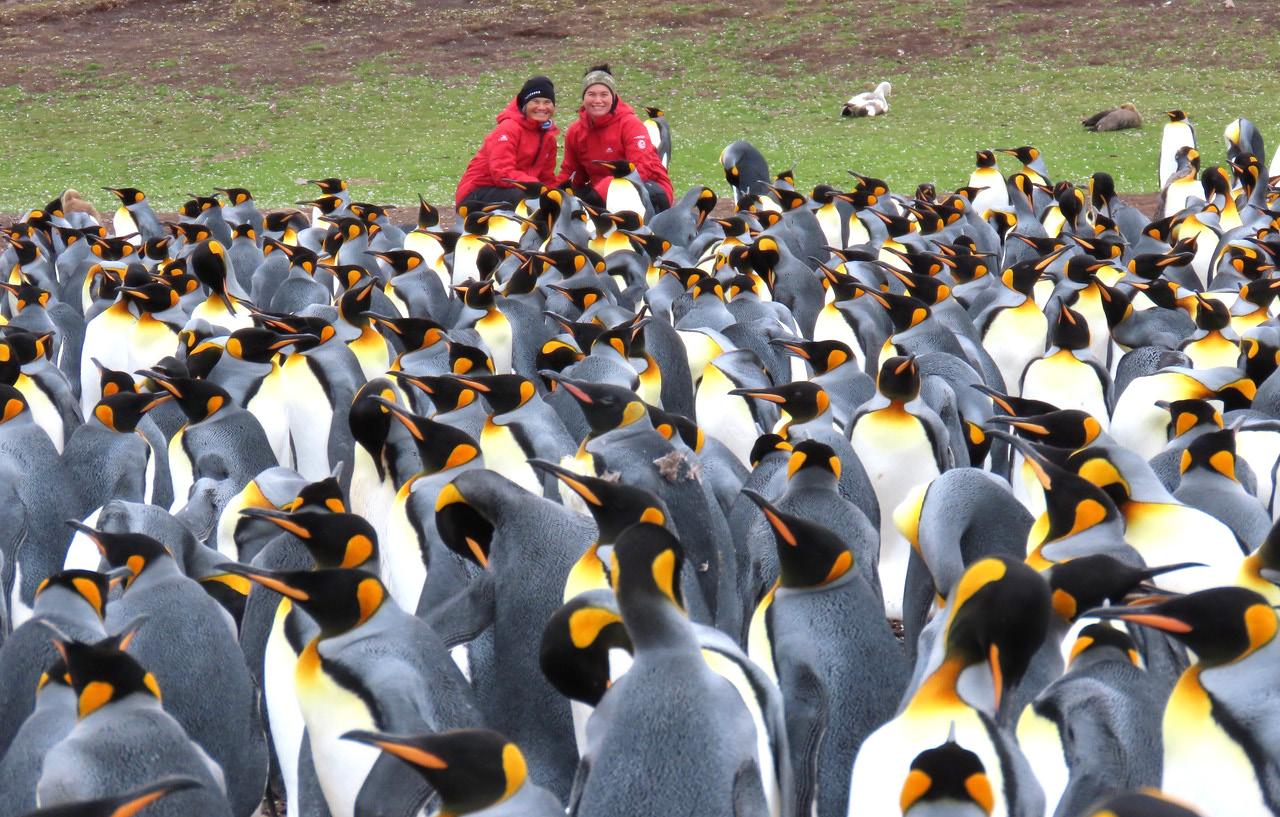
would have our trip curtailed by weather or other issues, would be pummeled by the Drake.
Instead, we had eight days of expedition activities, and the weather, views and wildlife got better and better. We lost a day in the Falklands, rearranged plans in South Georgia (partly due to Avian flu impacts), then had great weather in Antarctica, wrapping up with a shockingly calm Drake Lake coming back.
If you know Viking, you know the ship, staff and food were fabulous.
The expedition crew did a nice job juggling the logistics of schedule changes and excursion on its kayaks, Zodiacs, special operations boats (SOBs) and two submarines. We were disappointed there were so few wildlife alerts and staff on the lookout with guests, unlike our Arctic expedition in May with Quark.
We’re very active scouters and saw oodles of seabirds including albatrosses; four types of seals (fur, elephant, Weddell and crabeater); six types of penguins (king,
gentoos, macaroni, chinstrap, Adelie and Magellanic); and three types of whales (fin, humpback and orca, briefly). We couldn’t believe how many humpbacks we saw, and how close they were!
We got to admire the world ’s largest iceberg, A23A, for hours; were the first to kayak in a glacial lake that had been frozen until now; rammed the ship into sea/ fast ice twice; threaded icebergs in kayaks to get closer to whales; learned about Viking ’s commitment
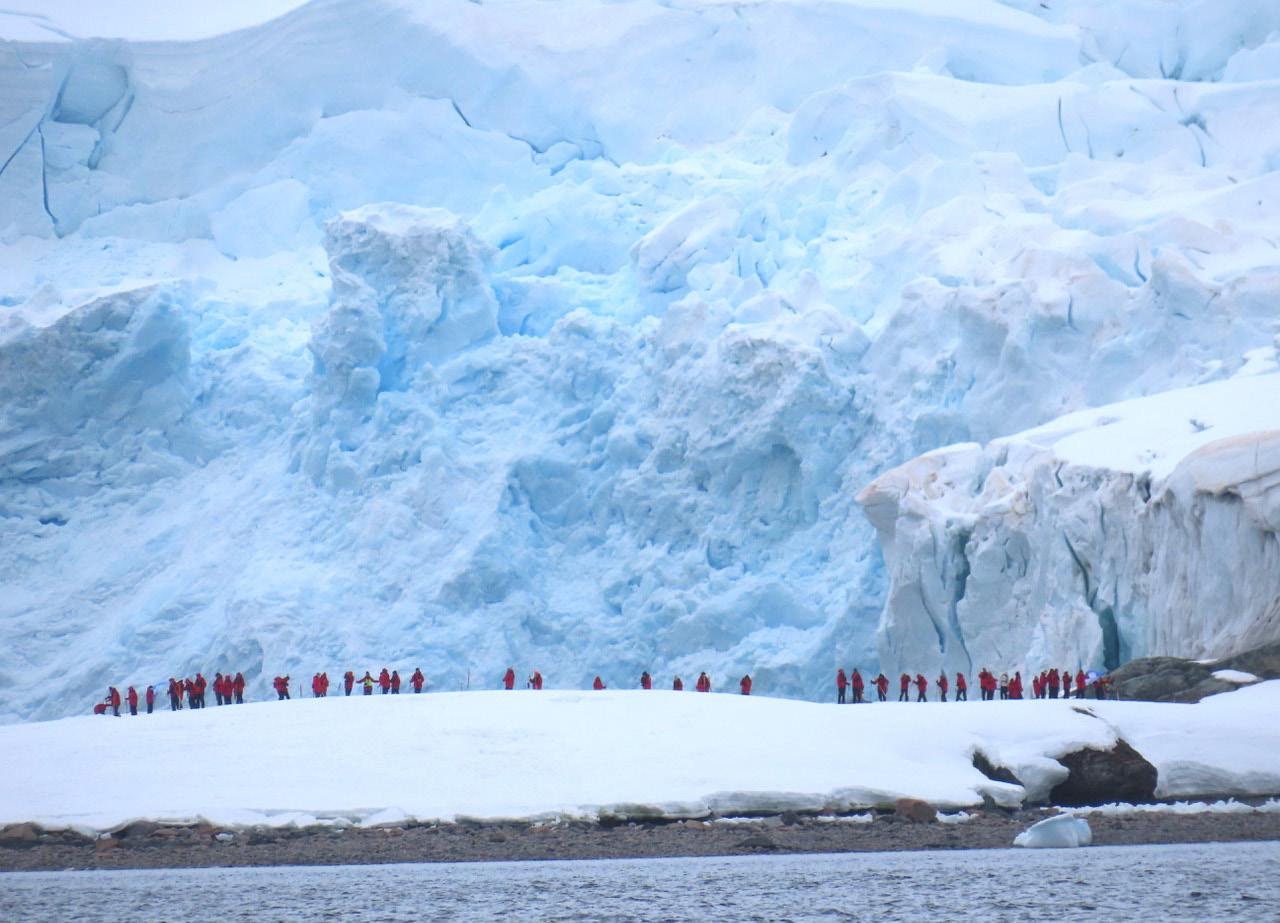
to research; and, of course, WALKED ON THE CONTINENT at Recess Cove.

That was on our last day in Antarctica, and was simply magical with sparkling glaciers, ice and sea; gentoo penguins welcoming us; whales frolicking RIGHT BY US. Recalling it still takes my breath away.
Contemplating a visit? Here are answers to your most pressing questions:
1. What was the weather like? Mostly around 33 degrees, with frequent ferocious, frigid winds.
2. How bad was the Drake? This 500mile passage between Argentina and Antarctica, where the Atlantic, Pacific and Southern seas collide, can be dreadful with waves up to 40 feet. We got lucky with the Drake Lake vs. the Drake Shake. Our itinerary included two days of the Drake vs. four if you only go to Antarctica. There are also fly-options to skip some of the Drake!
3. Who owns Antarctica? No one. Twelve countries signed the Antarctic treaty in 1959, committing the area south of 60 degrees south latitude to peaceful purposes only.
4. What’s the difference between Antarctica and the Arctic?
Simplistically, the Arctic is by the north pole and has polar bears. The Antarctic is by the south pole and has penguins.

The Arctic is an ocean surrounded by continents. Antarctica is an ice-covered continent the size of the U.S. and Mexico combined.
5. Which itinerary should I pick? There are many 8 to 10 day cruises from Ushuaia, Argentina, to the accessible northwestern portion of Antarctica (with four days in the Drake). We did not feel it was worth the trip without adding the Falklands and South Georgia with its vast numbers of wildlife including king and macaroni penguins and seals. This itinerary is offered less frequently and takes longer. We highly recommend it!
6. How fit do I need to be? Like any cruise, you can enjoy yourself just staying aboard. To get off the ship, you’ll need to get in and out of vehicles floating on water, and step into two feet of water for landings. There are numerous helping hands as well as step stools as needed.
7. When should I go? The season runs October to March. Usually, earlier is more ice, nesting
penguins and seal pups; later is more chicks and whales. (But we had AMAZING whale encounters in December!)
8. Which ship should I pick? As tourism grows – 80,251 people made landings in Antarctica last season vs. 27,374 10 years ago –expedition options are increasing. Most will carry 200 passengers and offer a variety of included activities. Prices start around $10,000 per

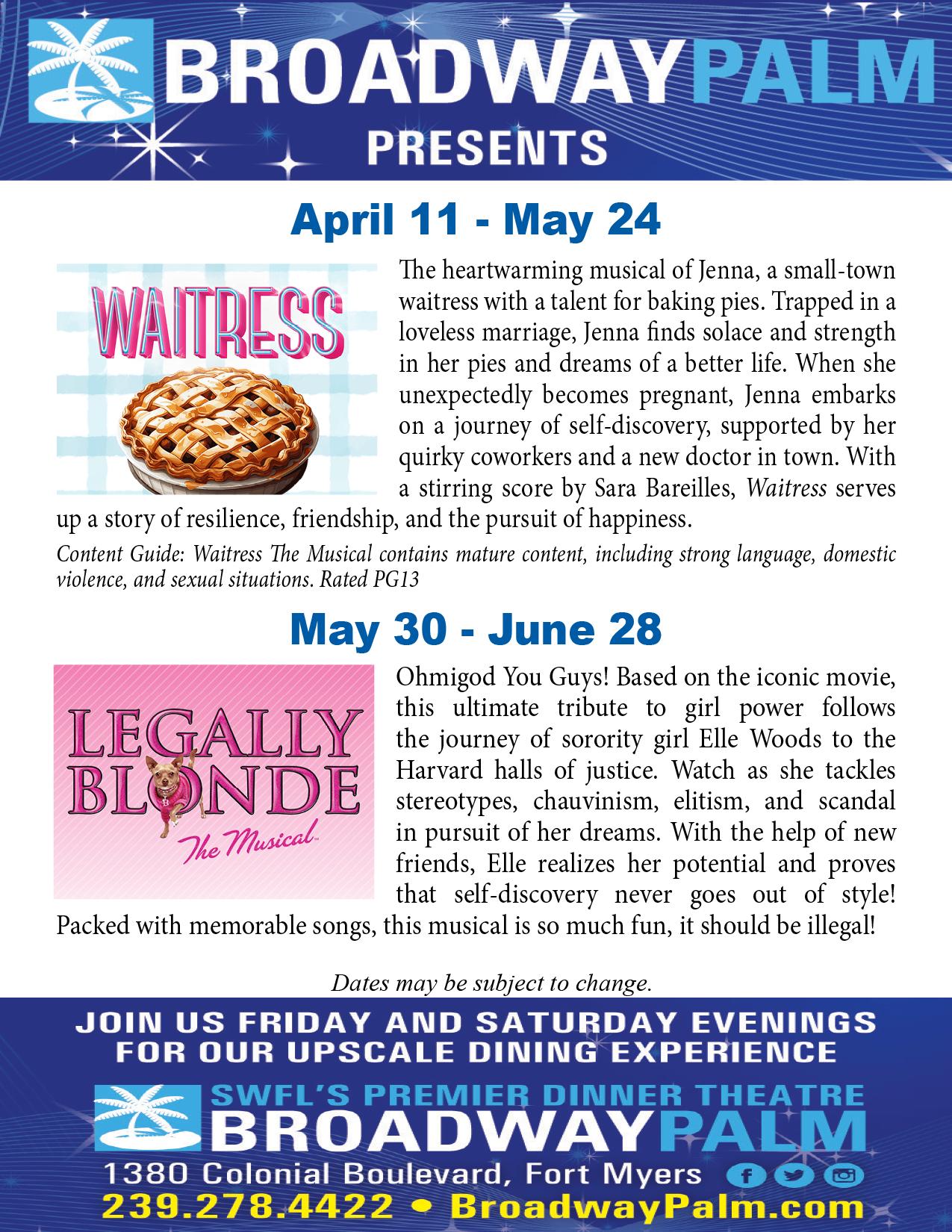
person and climbs much higher for the luxury lines. Larger cruise ships also go to Antarctica but are not allowed to do any landings if they hold 500 passengers or more.
9. How do you get there? Most will embark at Ushuaia, Argentina. You’ll likely fly into Buenos Aires, Argentina or Santiago, Chile.
Interested in more? Check out our top photos: https://photos.app.goo. gl/CzyikJgCZ2AZp8YFA
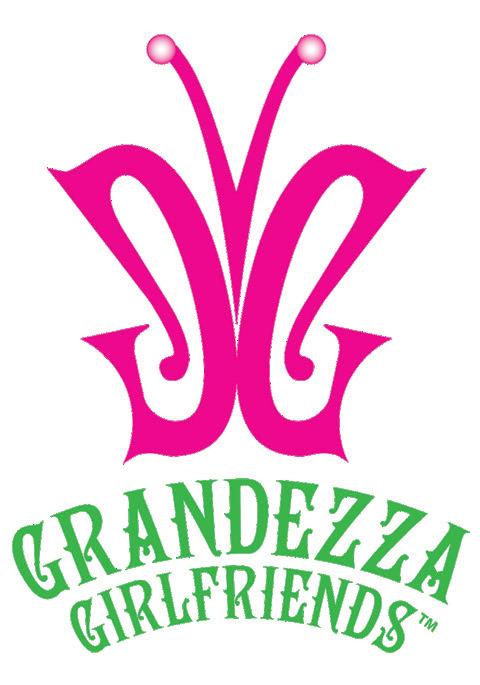
Fashionistas gathered in March for our best attended event of the year, our annual fashion show and luncheon. Hilary Moleski directed this year’s spectacular show and D.J. Darlene Polyschuk provided the tunes. Modeling clothes by Cabi were Kara Nickolas, Wendy Cohen, Regina Staudt, Kelly MacKay, Jill McRae, Jennifer Seegers, Ann Hayes, Alice Farling, Jeri Ojeda, Audrey Heaton, Rachel Johnson and Mel Borley. Throughout the show, we saw how a few staple items could be worn various ways.
Kudos to all who helped make this show a success, proving again that It’s truly a team effort!
Additionally, we celebrated the birthdays of Jody Altschule, Jane Christ, Shirley Cook, Cindy Fiddler, Patti Hafendorfer,


Felice Hurwitz, Susan Koepp, Sue Koser, Joan Lapatin, Patricia Lowe, Yvonne Mazzella, Sharon McCarthy, Pat Mother, Lee Nicosia, Debby Rudy, Lynn Senese, Vidu Sharma and Susan Stanczak. Karen Erdall was the lucky recipient of the Girlfriends bracelet.




Tell us about your pet(s)! Every month we will feature one family’s pet(s) in an article in the Grandezza Gazzette. All you have to do is write between 300 and 600 words about your much loved dog, cat, or other animal and include a couple of high resolution pictures. Some ideas to show off your loved pet include: how you named him/her; a description of his/her looks; favorite activities and toys; what makes him/ her special to you, and whatever else you’d like to share with readers. This offer is limited to Grandezza owners and residents.
Your submission doesn’t have to be a literary masterpiece; we will edit and format it for the monthly newsletter. Have fun writing about your pet, and submit it to sjsherwin18@gmail. com for submission in the Grandezza Gazzette.

When Bill and I decided to find a new doggie, we agreed to find another poodle after we lost our dear Sophie who lived just shy of her 18th birthday. She was an apricot poodle, a cross between a toy and a miniature, weighing about 11 pounds. We were so devastated after losing Sophie that we waited a year and a half before moving forward with a new pet.
I also decided that I wanted a smaller doggie to fit more easily under the seat as we flew back and forth between Chicago and Estero. We settled on a pure-bred toy poodle who was small enough to fit into a little carryon bag and had hair (rather than fur) that didn’ t shed. Poodles are said to be hypoallergenic.
After an Internet search, we consulted a friend of ours who was very knowledgeable of the dog breeding world. She quickly told us to avoid the Amish farms that breed dogs as part of their income stream. Finally, we found a breeder
of toy poodles who happened to be, in all places, in Estero, Florida. Go figure. Our breeder interviewed us to decide if we were worthy of adopting one of her poodle puppies. Thankfully, we passed the test.
Prior to our official adoption, Bill and I researched French names for our new little girl. Independently, we arrived at the same name. “Jolie” means “ pretty girl ” or “ pretty one” in French. How perfect for the little girl poodle we were about to adopt!

Both of Jolie’s parents are former AKC Champions. While we didn’ t need a fancy poodle, we wanted one with a good blood line to avoid inbreeding issues. Also, while this may sound a little strange, we decided to “ test” the puppies to find the right fit for us. We had the choice between two little girls. So, we used a couple of simple tests and selected Jolie, who passed with flying colors.
Jolie was born pure black and looked like a baby monkey. When we were able to claim her after Hurricane Ian , she weighed in at 2.2 pounds. She


was so tiny! She could fit into the palm of our hand. We had to be super careful not to step on her or drop her. She was very wiggly! As she aged, her nose grew, and her true colors started to show. Now she is considered a “silver ” poodle. And while we agreed with the breeder not to breed her or to show her, she shows signs of her AKC Show breeding just by the way she stands. She is a proud little poodle. She is not cut as a “show poodle,” but has a puppy cut with a little height on the top of her head.
Jolie is now two years and seven months old. She is super smart and also a little stubborn. She weighs seven pounds. She loves her parents and especially her mom. Her pet ID tags reads, “ Keep calm and call my mom.” She enjoys, and we know this is hard to believe, dressing up and meeting new people and other dogs. She has a fairly extensive wardrobe, thanks to gifts from a number of her “aunties.” She likes all dogs until they don’ t like her. She is quick to run into her mother ’s arms if she senses trouble or she is hurt. She is a picky

eater, that is, unless she senses that you are eating something she might like. Then, she will sit at your side until a small bite comes her way. She is not a fan of the groomer or the vet, but she sees both on a regular basis. She has an amazing vocabulary. Her favorite words are “cheese,” “chicken,” and Auntie Anyone. She knows her Aunties will give her just about anything she requests. After all, they are not her mom.
Hope you enjoy the photos! You can see Jolie most days in the Oakwood neighborhood, touring Avalon or checking out the driving range.
BARRY BLANK

If you are familiar with Amor Towles and perhaps have read any or all his previous works I am sure you will find Table for Two a worthwhile endeavor. The six short stories precede a novella with a varied subject matter and characters. The first short story is titled “The Line” and first takes place in Russia with a peasant farmer named Pushkin and his wife Irina. Their life is simple in the times of the Tsar in a village one hundred miles from Moscow. The author transitions to a city life in Moscow and writes through the life of Pushkin with all the limitations of living in a communist society.
In the next story “The Ballad of Timothy Touchett” the main character Timothy fancies himself a writer who has not experienced any profound traumas that could be an inspiration. He takes on employment with a bookstore owner, Mr. Pennybrook, who exploits Timothy’s naivety for economic gain. This story is relatable to a sheltered child.
In “Hasta Luego” flights from LaGuardia are delayed and then cancelled that bring Jerry and Smitty together, having not known each other prior. The story begs the question of to what lengths would you help a fellow human being?
The story “I will Survive” has to do with marriage, trust and interference between Peggy, second husband John and daughter Nell. It begs the question of whose life is it? Also maybe help may be asked for but not really wanted.
“The Bootlegger” involves Carnegie Hall concerts during which a young good looking Goldman Sachs investment banker observes that an older gentleman, Arthur Fein, sitting next to him is taping the concerts. This offends the banker on principle as well as the violation of the copyright laws. When is it right to break from the norm and perhaps bend the law?
“The DiDomenico Fragment” is not only interesting but gives the reader a glimpse into the world of art and the sales. Under consideration is the love of art vs. the intrinsic value of the piece.
The novella Eve in Hollywood is more in the writing of Towles’ typical style in its development of the characters. Contrasting elements of Los Angeles of old with gangsters, grifters and prostitutes conveys both the grit and glamor of the appearance of Hollywood. This a definite read and page turner.
I hope this short synopsis piques your interest to read both for the short attention reader as well as the serious reader. I wish to personally thank Felice Hurwitz for lending this book to me unsolicited.
JOHN DEJOY
At John Palmer’s Bistro we always loved to present the Asian flavors. We make Kung Pao Chicken, Potstickers and all kinds of various other tasty items. This marinade was developed for a Grilled Pork Tenderloin dish.
1 cup soy sauce
1 cup olive oil
1 cup chopped ginger root
1/2 cup rice wine vinegar
1/2 cup honey
1/4 cup minced garlic
1/4 cup sesame oil
Pinch of red pepper flakes
Mix all ingredients in a large bowl. Add trimmed pork tenderloin and seal tightly, save in the fridge. Let this rest overnight at the very least. Grill and enjoy. You could also sear this and finish in the oven if a grill is not available.

We accompanied this dish with Wasabi Mashed Potatoes and Kimchi Glaze. We made the kimchi. I would purchase it for home use!!! This dish was a hot seller for a long time. Please notice that no salt was added. The soy provides enough. Enjoy.
Compliments of Chef John and Michelle De Joy, Owners of John Palmer’s Bistro 44, in Concord, Ohio, and currently Saraceno residents.

BRIAN D. HURWITZ, PH.D. (HASTINGS ON HUDSON, NY VOLUNTEER FIRE DEPARTMENT EMT)
Imagine you are playing a round of golf on the Grandezza golf course when an emergency strikes. One of your golfing partners is down. Is it cardiac arrest, hyperthermia, or a reaction to an insect bite? Seconds count. Jump into action! Tap your stricken partner hard on the shoulder and yell loudly! If they don’t move, speak, blink, or otherwise react, or if they are not breathing or only gasping for air, call 911. Give the dispatcher the golf course’s name, the hole number, and whether you are on the tee box, fairway, or green. Within seconds of your call, Estero Fire Rescue, with arrival times under seven minutes, is on the way.
Immediately begin chest compressions (push hard, push deep push fast, at rate of 100 to 120 per minute), and call our Pro Shop or clubhouse. Club personnel will dispatch a “ranger” with an automatic external defibrillator (AED). While waiting, keep the chest compressions going. Because chest compressions are tiring, have someone else jump in. Take turns.
How does EMS locate you? I posed this question to Jennifer Krohnfeldt, Estero Fire Rescue Community Education Specialist. She explained that her husband, Fire Lieutenant Jerry Krohnfeldt has walked every golf course in Estero, including Grandezza, to verify access points for all 18 holes. Estero Fire Rescue has a Geographic Information System (GIS) map created by Lee County that details 8,000
mapped access points at all 108 Lee County golf courses. Fire departments conducted walkthroughs and drivethroughs of each course to verify that the designated access points are accessible. Fire and EMS crews also performed mock drills to test response times using the mapped coordinates.
The coordinates were uploaded into the Lee County 911 dispatch system. Now when you call 911 dispatchers, they can cross-reference your GPS location with the pre-mapped emergency coordinates displayed on a screen in front of them and will guide first responders to you with pinpoint accuracy.
For example, if you are on the number four fairway at Grandezza, the dispatcher’s view shows the corresponding home addresses along Markward Crossing in Grande Estates, with access points to the hole No. 4 fairway and to your mobile phone’s GPS location. Every home address along Markward Crossing has been checked to make sure there are no obstacles through backyards closest to you.
Similarly, according to Lee County’s GIS maps, at the Eagle Ridge Golf Course, the No. 10 fairway corresponds to 7627 Eaglet Ct., with notes indicating “on the
golf course behind the address” to facilitate a swift response from EMS. If the AED dispatched by the Pro Shop or club gets to you before Estero Fire Rescue, do not be afraid to use it. An AED, or automated external defibrillator, can restore the heart’s normal rhythm during an incident of sudden cardiac arrest. It will walk you through the necessary steps to deliver the lifesaving shock to restore your friend’s heart to a normal rhythm. Although such an emergency occurring on our golf course is unlikely, being prepared can make all the difference.
The Grandezza United Way Committee is proud to announce that our Grandezza Community has achieved 100% of our United Way campaign goal again this year. Since its inception in 2009, our community has donated a total of $1,968,000 to the United Way of Lee County.
On behalf of the Lee County United Way, we want to express our deepest appreciation to all those who so generously participated in this year’s campaign.

With 96.3% of every dollar going to support qualified local charities in Lee County you, our donors, are helping to change people’s lives by recognizing that every donated dollar is important to someone in need. Thanks again to all our 2024-2025 campaign donors.
Best personal regards, Grandezza United Way Committee Members
Peter Dersley, Mary Kay and Deemer Durham, Bill and Pat Motzer, Dennis Noice, Don Platt, Patty and John Polczynski, Winnie Powel, and Pat and Neal Van Duyn
BARRY S. BLANK D.D.S., M.SC.D.,
RETIRED PERIODONTIST, PROFESSOR AND LECTURER
A private interview with James Metz, DDS, FACD, ABDSM and Diplomate of the American Board of Dental Sleep Medicine and Chair of the Dental Interest Group of The American Thoracic Society
What Seniors should know about obstructive sleep apnea
As our population ages, healthcare professionals increasingly highlight the importance of recognizing and addressing obstructive sleep apnea (OSA) among seniors. This sleep disorder, characterized by repeated interruptions in breathing during sleep, can lead to serious health complications if left undiagnosed and untreated.
Obstructive sleep apnea occurs when the muscles at the back of the throat relax excessively during sleep, causing a temporary airway blockage. This can result in fragmented sleep and reduced oxygen levels in the blood. Common symptoms include loud snoring, gasping for air during sleep, excessive daytime sleepiness, and difficulty concentrating.
Seniors are particularly vulnerable to OSA due to several factors. Age-related changes in muscle tone, increased body weight, and the presence
of other medical conditions such as hypertension or diabetes can all contribute to the likelihood of developing this disorder. Additionally, medications that seniors may take for various health issues can exacerbate sleep apnea symptoms.
The consequences of untreated obstructive sleep apnea can be severe, especially for older adults. Research indicates a strong correlation between OSA and cardiovascular problems, including hypertension, heart disease, and stroke. Moreover, individuals with OSA may experience cognitive decline, depression, and an increased risk of accidents due to daytime drowsiness.
Seniors and their caregivers should be vigilant for signs of sleep apnea. If you or a loved one experiences heavy snoring, gasping, or choking during sleep or if excessive daytime fatigue becomes a regular issue, consult a healthcare professional. Documenting sleep patterns and symptoms can

assist in identifying the problem during medical consultations.
Healthcare providers may use various diagnostic tools, including sleep studies, to confirm the presence of obstructive sleep apnea. Once diagnosed, treatment options can range from lifestyle changes and continuous positive airway pressure (CPAP) therapy to oral-dental appliances and, in some cases, surgical interventions. Lifestyle modifications, such as weight loss, regular exercise, and avoiding alcohol or sedatives before bedtime, can significantly improve symptoms. CPAP therapy, which uses a gentle stream of air to help keep the airway open during sleep, is often the most effective treatment for moderate to severe cases.
Seniors and their families should prioritize awareness of obstructive sleep apnea as a significant health concern. Early diagnosis and intervention can improve quality of life, better overall health, and reduce the risk of serious complications. Healthcare professionals encourage seniors to talk openly about sleep issues with their doctors and seek evaluation if they notice symptoms of OSA. Individuals can reclaim their sleep and enhance their well-being with the right approach.
Obstructive sleep apnea is more than just a nuisance; it’s a health condition that can have far-reaching effects, particularly for seniors. By understanding the risks and recognizing the signs early, seniors can take proactive steps toward better sleep and improved health outcomes. As always, staying informed and engaged in one’s health is key to enjoying a fulfilling and active lifestyle in later years.
PAULA EDWARDS-NOICE
The Children’s Advocacy Center is instrumental in providing a coordinated response to child victims of abuse and neglect. Its mission is to enhance the lives of at-risk children and their families through their comprehensive prevention services. This past year, CAC provided crucial services to more than 2,000 children and adults in Southwest Florida.
A group of thirty women Grandezza golfers recently donated over $1,700 in bed linens, bath towels, baby supplies and toiletries. These donations were delivered to the center on February 24. The group then
toured the recently remodeled facilities and learned more about the work of the agency.
The generosity of donors like these Grandezza women is vital to CAC’s mission of offering a safe haven for abused and neglected children, ensuring their voices are heard and their needs are met.
Mary Jo Sorrento, Celia Platt, Judy LaValley, Christine McGill, Paula Noice, Kaleigh Lawrence (CAC Chief Development Officer), Nyra Rohskopf, Sheila Vogt, Pat Parry, Toni MacLeod, and Terry Richard.
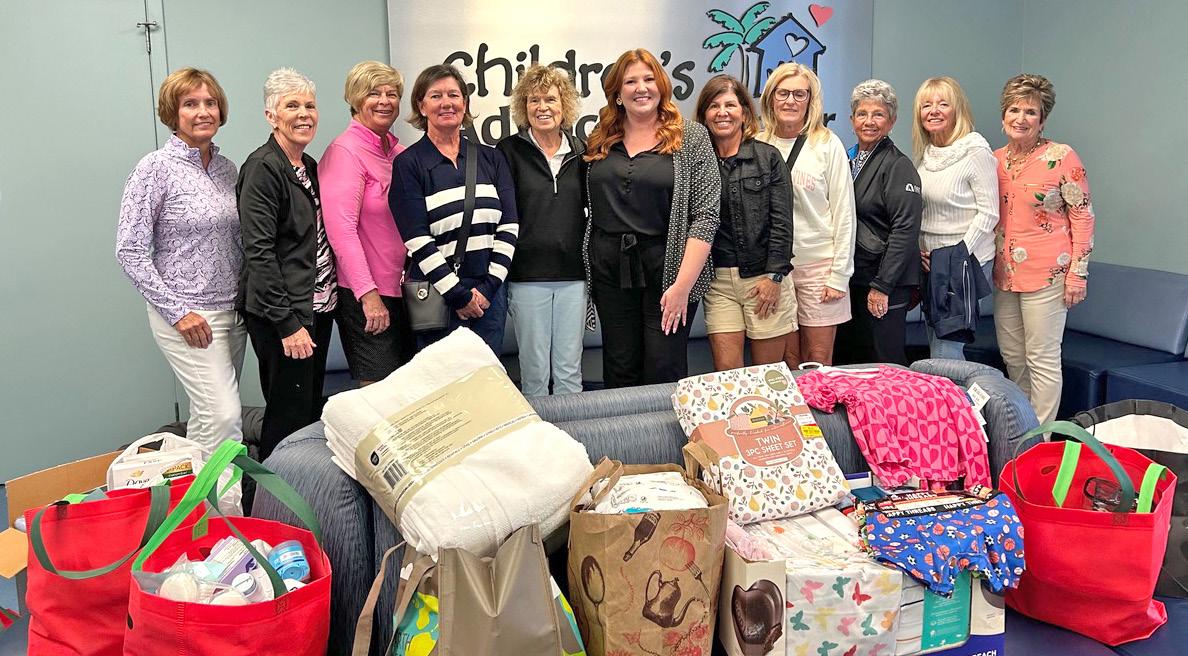
• PRETEND to be from an agency or organization you know.
• Say there’s a PROBLEM or promise a prize.
• PRESSURE you to act immediately.
• Tell you to PAY in a specific way.
Do not give scammers money or personal information – Ignore them!
How to avoid a scam:
• Remain calm. Talk to someone you trust.
• Hang up or ignore the message. DO NOT click on links or attachments.
• Protect your money. Criminals will insist that you pay in a hard-to-trace manner, such as with a gift card, prepaid debit card, cryptocurrency, wire transfer, money transfer, or by mailing cash.
• Protect your personal information. Be skeptical of a contact you didn’t initiate.
• Spread the word. Share your knowledge of Social Security-related scams. Post on social media using the hashtag #SlamtheScam to share your experience and warn others. Visit ssa.gov/scam for more information. Please also share with your friends and family.

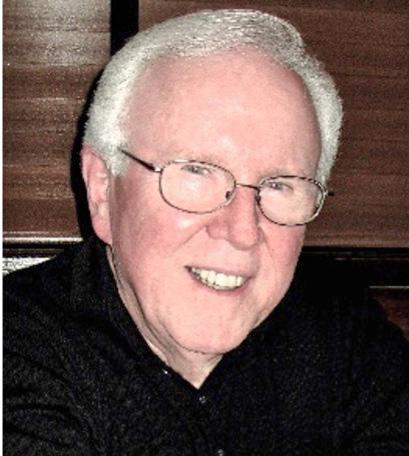
Engage Estero is pleased to announce an exciting leadership transition strengthening its commitment to our community’s wellbeing. Jim Gilmartin, the president, will move on to the board of directors. This move allows Jim to continue guiding Engage Estero with his visionary insights and strategic expertise, ensuring our organization remains steadfast in its mission to enhance the quality of life in Estero.

Allan Bowditch, Engage Estero’s Chief Communications Officer, is stepping into the role of President. Allan and his communications team have enhanced the quality of the information Engage Estero provides to its growing number of residents, now over 12,000. Allan’s background as former CEO and Chairman of a leading international marketing consulting organization and his leadership style position him perfectly to lead Engage Estero into this new era.
Lisa Khorey will oversee Communications with Mike Wasson as deputy. The rest of the team comprises Kim Dailey, the communications coordinator and Webmaster, Heather Doane, Zach Katkin, and Kim Henderson.
Some Key Outcomes from the Community Meeting on Road Safety Feb. 26
Although a complete summary of the meeting and the YouTube video are available on the website www.esterotoday.com, a few key points emerged.
• During the 5 years of a recent crash analysis, there were 3,000 crashes in Estero! Eighty of these resulted in a serious injury or fatality. This is higher than the expected average in Florida.
Mathew Maher, Senior Associate, Traffic Engineer, Stantec Consulting, has put forward several important recommendations:
• To limit traffic turning right or left at US 41 and Williams Road light only on the green arrow. They will be prevented from turning across the south and north moving traffic after the green arrow signal has stopped – it will then be red.
• Line of sight: Ensuring that landscaping does not interfere with one’s ability to see clearly at a junction.

• Improving crosswalk visibility: Parallel lines are being replaced by cross-hatching and ladder-style markings that are far more visible. Lighting is also a factor in specific locations that involves floodlighting solutions focused on the pedestrians.
• Vehicle Detection Technology to avoid T-bone crashes at traffic lights: In Lakeland, the municipality has implemented several modifications. We’re seeing measures that could be adapted to county or state signals in the future.
• The value and importance of roundabouts in reducing serious accidents and speeding traffic flow.
Carmen Monroy, Senior Transportation Manager, CTS Engineering, explained the importance of embracing workforce housing in Estero to help reduce commuter traffic. Ensuring local workers have more affordable apartments or homes not only reduces traffic coming into Estero but encourages key workers like teachers, healthcare workers, support staff of many types, and first responders to remain in their place of work to avoid disruption and the difficulties employers face in having to seek new staff repeatedly.
Don Scott, Executive Director of the Lee County Metropolitan Planning Organization, referred to the earlier details of the proposed MPO plan:
• I-75 widening from Golden Gate Parkway to Corkscrew Road – 6 to 8 lanes
• Three Oaks Extension from North of Alico Road to Daniels Parkway – New four lanes Phase I under CST
• I-75 and Daniels Interchange – DDI (diamond exchange) and 8 lanes from Fiddlesticks to I-75 (8 lanes in Three Oaks Phase II)
• Corkscrew Road from Bella Terra to East of Alico Road – 2 to 4 lanes under CST completion Spring 2026
• Alico Road Connector from Airport Haul Road to SR 82 – New four lanes.
The projects that will start soon (in 2 years) include widening I-75 to 8 lanes from Golden Gate to Corkscrew Road, which should be accomplished in the next 5 years. Three Oaks Parkway will also be extended from Alico Road to Daniels, and an 8-lane section on Daniels from Fiddlesticks to the I-75 interchange will also be completed.
The extensive information, together with the many questions that were addressed, can be accessed on the website www.esterotoday.com .
The April Community Meeting at The Estero Recreation Center April 23 at 10:30 a.m.
The meeting will cover:
• Improvements in the treatment of pancreatic cancer.
• Improvements in getting AEDs to patients in need quickly.
• The Rights for Clean Water in Greater Estero.
Engage Estero is pleased to inform residents of the upcoming meeting on April 23 at 10:30 a.m. at the Estero Recreational Center. The topics being covered will provide important information about the steps being taken locally and elsewhere that could provide valuable information to help enhance the quality of life that Estero can offer residents. The speakers are:
• Dr. Mark Bloomston, M.D., Medical Director, Florida Center for Pancreatic Diseases, Lee Health
• Brian Hurwitz, Member of the Engage Estero Health Committee
• Joseph Bonasia, Operations and Communications Director for FloridaRightToCleanWater.org
At Engage Estero, we believe in the strength of the community. As a nonpartisan, nonpolitical nonprofit, we utilize evidence-based research to provide nonbiased information about community issues, empowering you to improve your quality of life.
In an effort to make the Grandezza Gazzette interesting and readable to our residents, we invite you to share your stories, experiences, and perspectives. We welcome articles about books, travel, pets, sports, TV and movies, tech, and/or content that will get our community talking and sharing! Just avoid topics such as politics and religion in keeping with our policy of avoiding controversy.
Please try to limit your words to between 200 and 600 words and feel free to include a couple of jpeg photos with high resolution. We’ll be happy to give you a byline!
Send your submissions to sjsherwin18@gmail.com.
DARREN ORF, INTERESTING FACTS
It’s a fact of life – people grow old. While modern society tends to obsess about the negatives of aging, studies suggest that we often experience more happiness and contentment in our later years. These 12 facts investigate the phenomenon of growing old, debunk some persistent myths about aging, and explore the brighter side of those golden years.
As our bodies age, they naturally become more susceptible to a variety of illnesses and maladies – but migraines are the rare exception. Migraines often first develop in adolescence, and while both sexes are affected, women are three times more likely to develop migraines compared to men (often due to a fluctuation of estrogen levels). However, the frequency of migraines eventually peaks at the age of 40 and actually gets better as we enter our golden years. Stress and hormones are the most common triggers for migraines, and these two factors usually affect older people with less severity. That said, pain, smoking, and alcohol can still contribute to migraines in seniors, and although migraines generally subside with age, they are still the second-mostcommon headache disorder in older people (after tension headaches). One in 10 older adults still experience them about once a year.

One of the hallmarks of aging is that our lifelong hair color begins to turn gray, or in some cases, white. Although an entire industry is built around hiding this fact, human hair isn’t actually turning gray so much as no longer supplying the pigments necessary to produce color. This occurs when hydrogen peroxide builds up after wear-and-tear on the hair follicles. That blocks the normal synthesis of melanin, which is responsible for all shades of hair color.
As people age, we also gain a certain calm. A study published in 2016 in the Journal of Clinical Psychiatry analyzed a random sample of 1,546 people ages 21 to 100 in San Diego. Although younger people in the survey responded positively in terms of physical health compared to older folks (as anticipated), older adults far outperformed younger generations in terms of mental well-being. Panic disorders are also
reported as less common among older cohorts compared to younger people, and developing a panic disorder later in life is a rarity.
As we age, our skin loses collagen, gets thinner, and presses our sweat glands close to the surface of our skin. This process is a bit of a double-edged sword. On the one hand, because these glands are squeezed, it’s harder for sweat to come out of our pores, meaning older people sweat less overall. This may be a check mark in the “pro” column for personal hygiene, but it does come with a few negative side effects. With a reduced ability to sweat, older adults can have trouble regulating temperature during strenuous exercise or excessive heat. Sweat also plays an important role in healing, as it helps stimulate wound closure in skin cells. Thankfully, a lifetime of physical fitness helps slow down this process so you can sweat long into your golden years.
Older people may not feel as strong as they did in their youth, but in terms of political power, they’re as strong as ever. In 2018, 64% of people 65 and over voted in the U.S. midterm election – the highest turnout of any age group – and the 65- to 74-year-old cohort also had the highest turnout in the 2020 election. There are a couple of reasons why the older vote is particularly robust. The biggest may be that older Americans,
as well as seniors in other democracies, have government programs and initiatives they rely on, such as Medicare, prescription drug pricing, and Social Security, and because these policies so directly affect them, elections tend to turn out seniors in higher numbers. (There are other factors at play, too – older folks may simply have more time on their hands.) Senior citizens also grease the wheels of democracy, as they’re the most likely age group to volunteer as poll workers on Election Day.
While a common myth purports that our ears and nose continue to grow as we age (while the rest of us generally shrinks), that’s not entirely true. Like most other parts of our body, our ears and nose stop growing once we’re in adulthood, but the constant tug of gravity over the decades causes these cartilage-filled features to droop over time. This constant pull actually causes the collagen and elastic fibers in our ears and nose to elongate, and this lengthening, combined with surrounding facial structures losing overall volume, often produces the illusion of growing ears and noses as we age. This elongation is a slow and steady process; studies have shown that ears can lengthen some 0.22 millimeters a year. Interestingly, the process is so precise that you can discern a person’s age just by measuring their ears.
A common misconception about old age is that it’s a relatively modern phenomenon, as our predecessors lived brutish lives cut

CREDIT: HERITAGE IMAGES / HULTON FINE ART COLLECTION VIA GETTY IMAGES
short by disease and war. While modern medicine has certainly expanded life expectancy, many people in the past lived as long as people live today. For example, some ancient Roman offices sought by politically ambitious men couldn’t even be held until someone was 30 – not exactly a great idea if people didn’t live many years beyond that. Scientists have analyzed the pelvis joints (a reliable indicator of age) in skeletons from ancient civilizations and found that many people lived long lives. One study analyzing skeletons from Cholula, Mexico, between 900 and 1531 CE found that a majority of specimens lived beyond the age of 50. Low life expectancy in ancient times is impacted more by a high infant mortality rate than by people living unusually short lives. Luckily, modern science has helped more humans survive our vulnerable childhood years and life expectancy averages have risen as a result.
Another myth about getting old is that as we age, humans need less and less sleep, somehow magically subsisting on six hours or less when we enter our senior years. The truth is that the amount of
sleep a person needs is only altered during childhood and adolescence as our bodies need more energy to do the tough work of growing. Once we’re in our 20s, humans require the same amount of sleep per night for the rest of their lives (though the exact amount differs from person to person). In fact, the elderly are more likely to be sleep-deprived because they receive lower-quality sleep caused by sickness, pain, medications, or a trip or two to the bathroom. This can be why napping during the day becomes more common as we grow older.
The common perception of human biology is that our bones put on some serious inches in our youth, and then by the time we’re 20 or so, nature pumps the brakes and our skeleton stays static forever. While that’s true of a majority of our bones, some don’t quite follow this simplistic blueprint. A 2008 study for Duke University determined that the bones in the skull continue to grow, with the forehead moving forward and cheek bones moving backward. Unfortunately, this
imperceptible bit of a facial movement exacerbates wrinkles, because as the skull shifts forward, the overlying skin sags. The pelvis also keeps growing throughout your life. Scientists analyzing the pelvic width of 20-year-olds compared to 79-year-olds found a 1-inch difference in width, which adds an additional 3 inches to your waistband. That means our widening in the middle as we age isn’t just about a slower metabolism.
While our hips get bigger, our pupils get smaller. The human pupil is controlled by the circumferential sphincter and iris dilator muscles, and as we add on the years, those muscles weaken. Because of this loss of muscle function, pupils get smaller as we age, and are also less responsive to light. Smaller pupils make it harder to see at night, so people in their 60s need three times as much light to read comfortably as people in their 20s. Reading a menu in a dimly lit restaurant? Forget about it. Other eye changes include an increased likeliness of presbyopia, or farsightedness (which can often be resolved with readers), and cataracts, or a clouding of the eye’s lens. In fact, half of people over the age of 80 will have experienced a cataract of some kind.
Although the body experiences some slowing down as we age, growing old isn’t all bad news. Researchers from the University of Queensland found that older people had
stronger immunities than people in their 20s, as the body keeps a repository of illnesses that can stretch back decades. This extra line of defense begins to drop off in our 70s and 80s, but until then, our bodies generally just get better and better at fighting off disease due to biological experience. Additionally, as we age we experience fewer migraines, the severity of allergies declines, and we produce less sweat. Older people also exhibit higher levels of “crystalized intelligence” (or what some might call “wisdom”) than any other age group.
It’s true that age is just a number, and in the cosmic view of the universe, human age is pretty insignificant. The atoms that make up the human body are already billions of years old. For example, hydrogen – one of the key components of our bodies – formed in the Big Bang 13.7 billion years ago. Likewise, carbon, the primary component of all known life, formed in the fiery cauldron of stars at least 7 billion years ago. So when someone says we’re all made of “star stuff,” they’re very much telling the truth (we’re also made from various supernovae). And while we grow old on Earth, this is only the latest chapter of a story that stretches back to the beginning of everything – and it’s a story that’ll continue until the universe ends.
https://interestingfacts.com/growing-olderfacts-2/

To place a classified ad Grandezza residents may e-mail sjsherwin18@gmail.com. An ad will run for THREE (3) MONTHS beginning with the first submission. Please inform us when the item has been sold or if you wish to have it deleted from the column. Also, you must notify us to continue an ad for an additional cycle after the initial 3-month period has expired or it automatically will be deleted. (Ending cycle of the ad running is noted at the end in parentheses.)
FREE Chair/Stair Lift that will fit most any Sabal Palm second floor unit. Complete custom system with remote controls. I removed it from a unit that I renovated. Make your unit more accessible and save thousands of dollars. I will deliver for free and also reinstall for a minimal cost. Please call John at 508.801.5000 (Expires 5/25)
2000 CORVETTE, light pewter metallic with black interior, 43,000 miles. Fully loaded and working. One senior owner, no accidents. Always garage stored with full maintenance records. $23,000.00. Call 239-200-6192 (Expires 6/25)
, white, 37,500 actual miles. New battery, front and rear shocks, and a complete engine tune up. Very, very good condition. Great 2nd car for sunny Florida! Call Greg (Saraceno resident) for a test drive at 612-250-4163. $6900 or best offer. (Expires 6/25)
Bose Smart Soundbar 600, brand new, never opened in its original box, for sale $319. Please contact Aramis at 239-860-2071 (Expires 7/25)
with oversized tires. Like new, has been driven only a few times! Unable to ride because of physical health issues. Includes 5 star lock, helmet, tool gear adjustment. Asking $350.00 or best offer. Call 239-401-0939 (Expires 6/25)
2022 Advance EV 2 seat golf cart. Standard features include cooler, ball and club washer, seat belts, 2 sand bottles and USB plug. Upgrades include sound bar with Bluetooth, floor mat, club rain cover, and front tray for golf balls, phones and extra drink holders. Brand new front tires. Top speed is 26mph. Asking $5999. Text Jack at 513-205-0037 (Expires 7/25)
FREE replacement equipment supplies for a Philips Respironics Dream Station CPAP machine: 1 water tank, 1 head piece with mask,1 tubing and 7 masks size L. Contact Sue Lowney at 636-577-3444 (Expires 7/25)
TRAVEL PLANNING MADE EASY. Since 1976. No fees. Previous agent for American National Standards Institute, Pecos River Spice Co., Professional Touring Tennis pro and others. Larry @ Ljackman1@icloud.com (Expires 5/25)
The average person eats three times a day, which is more than 1,000 meals in a year. Add that to the amount of time we spend ordering happy hour appetizers, planning party potlucks, and discussing where to have dinner, and it’s no surprise that food has found its way into our everyday phrases, sayings, and expressions, too. Whether we’re “walking on eggshells” or “going bananas,” food seems to be always on the tip of our idiomatic tongues. Here are seven delectable idioms that really take the cake.
The person who is the “apple of your eye” is someone you prize above all others. The original context of this saying referred to the “aperture” or “ pupil” of the human eye . The phrase appears in William Shakespeare’s 1590s play A Midsummer Night’s Dream ( “ Sink in the apple of his eye”), as well as in the King James translation of the Bible from 1611 ( “ Keep me as the apple of the eye,” Psalm 17:8).
When earning a living by making money, you’re “bringing home the bacon.” This idiom has a few origin stories, one of which suggests that in the 1100s, married couples in a small town in England who visited the church and swore they hadn’t argued in the last year would be awarded a side of bacon to bring
home. Another story that popularized the phrase involves boxer Joe Gans receiving a telegram from his mother in 1906, encouraging him to “bring home the bacon” (the prize money) in a fight.

Folks have been baking bread almost as long as they’ve been growing crops. But buying presliced bread? That’s a newer option that requires automated machines to pull off in mass. The earliest effective bread-slicing machine was created by an Iowa inventor in the late 1920s. Chillicothe Baking Company was the first to sell presliced bread, so they used a version of this idiom in their advertising: “The greatest forward step in the baking industry since bread was wrapped.” Today, the phrase refers to excitement for a new concept or idea.
It’s important to diversify your efforts and assets — that’s why you shouldn’t “put all your eggs in one basket.” This idiom comes from an early 17th-century Spanish proverb commonly attributed to the 1605 novel Don Quixote by Miguel Cervantes. Translated from the original Spanish, it reads, “‘Tis the part of a wise man to keep himself today for tomorrow, and not venture all his eggs in one basket.”
When you’re in an easy situation with lots of benefits and low risk, folks might say you’re “riding the gravy train.” Some sources indicate this expression may date back to 1920s railroad workers who used it to describe an easy assignment that paid handsomely.
When taking something with “a grain of salt,” you view it with a skeptical eye and don’t interpret it literally. The phrase possibly originated with Pliny the Elder in 77 CE. He advised ingesting an antidote for poison with a grain of salt to make it more palatable. However, it wasn’t until the early 20th century that the figurative sense of swallowing hard-to-believe material with a grain or pinch of salt came about.
In life, as in cooking, sometimes you have to sacrifice one thing to make something else worthwhile. This idiom is generally attributed to the French soldier François de Charette, who defended King Louis XVI and Marie Antoinette during the French Revolution. Presumably, his quote, “Omelets are not made without breaking eggs,” was more about battle than breakfast. Since the sacrificial eggs in question for de Charette were people, perhaps it’s time we take this idiom off the menu.
https://wordsmarts.com/food-idioms/


Gatehouse (239) 498-8895
Gatehouse (DwellingLIVE Automated # to register guests) (239) 986-8627
Address 11450 Grande Oak
Clubhouse (239) 948-3569
Grandezza Express -
Take Out Food (239) 738-7113
Golf Pro Shop (239) 948-2900
Tennis Pro Shop (239) 738-7111
Wellness Director (941) 999-1331
Golf Maintenance (239) 947-6296
Vesta Property Services cmcfarland@ vestapropertyservices.com (239) 947-4552 x 932
Gazzette Editor for HOA
Susan Sherwin sjsherwin18@gmail.com (973) 615-4222
WWW.GRANDEZZAMASTER.COM
Grandezza is a safer community because of Neighborhood Watch. Avalon Peggy Dempsey 610-662-2082
Cypress Cove A (Buttermere) Mike Patricelli 239-495-6862
Cypress Cove B Kevin O’Neil 239-265-5982
Grande Estates Joy Schachner 239-676-9668
Oakwood I (bldg 1-8 & 23-29) Al Meyer 239-313-0580
Oakwood II (bldg 9-22) Lillian Bennett 239-992-5583
Sabal Palm Mary Kaufmann 216-406-5347
Santa Lucia Celia Platt 239-498-8158
Saraceno Neil Greene 239-498-7104 Savona Sharmin McKenny 239-989-2334
Solemar Bob Lindgren 651-895-6210
Ville Grande Steve Bajinski 678-575-2397
• Call 911 for a crime-in-progress (emergency) or
• Call the police at 239-477-1000 to report suspicious activity/behavior (non-emergency)
• Call the Grandezza Gate at 239-498-8895 to inform them that the police may be coming and why.
• Notify your Neighborhood Watch Coordinator
Poison Control (800) 222-1222
Alligator Hotline (866) 392-4286
Animal Control (239) 432-2083
Mosquito Control (239) 694-2174
Florida Power & Light (239) 334-7754
Sunshine Before You Dig (800) 432-4770
Waste Services of Florida (239) 332-8500
Free Residential Appliance Pickup (239) 337-0800
COMMUNITY BOARDS AND OFFICERS
ASSOCIATION POSITION
GRANDEZZA MASTER BOARD
Fred Thompson P
Peter Dersley VP
Mickey Wheeler T
Sarah Hartman S
Aramis Sullivan D
Mike Patricelli D
Susan Sherwin D
AVALON
Jim Schleifer P
Joe Convertino, Jr. VP
Pat Van Duyn T
Dan Marrazza D
Ron Gramazio D
CYPRESS COVE A
Andy Anderson P
Mike Patricelli VP
Dennis Field D
Myrna Wernick S
Paul Lesser T
CYPRESS COVE B
Toni MacLeod P
Chuck Dennis VP
Kevin O’Neil T
Frank Senese S
Yvonne Mazzella D
GRANDE ESTATES
Peter Dersley P
Cameron Snyder VP
Fred Thompson T
Laura Reddin S
Lanell Shields D
Finance & Long Range Planning
Mickey Wheeler ................................................. chair
Communications
Susan Sherwin .................................................... chair
Landscape
Aramis Sullivan ................................................... chair
Infrastructure, Lakes, Preserves & Fountains
Peter Dersley....................................................... chair
Safety & Access Control
Mike Patricelli ..................................................... chair
Community Affairs
Fred Thompson ................................................... chair
OAKWOOD NEIGHBORHOOD
Sandra Renner P
Ted Lewman VP
Patricia Collie S Al Meyer D
Steve Anderson T
OAKWOOD I
Rich Green P
Joe Trefaller VP
Tom Rajtik S/T
OAKWOOD II
Steve Anderson P
Richard Zimmerman VP
John Fillipo S/T
SABAL PALM
Shannon Palombo P
Ellen Kaplan VP
William Greenwald T
Julie Sexton S
Mark Sherwin D
SANTA LUCIA
Aramis Sullivan P
Mike Mainelli S/T
Celia Platt VP
SARACENO
Neil Greene P
Skip DeLong VP
Bob Hoel S
Matt Baumlin T
Dean Stefanac D
SAVONA
Brian Schultz P Wes Wilkins T
Paul Copper VP/S
Nancy Banyard D
Ann Cary D TBD D
SOLEMAR
Bob Lindgren P
Brian Vance VP/S
Dan Williams T
VILLA GRANDE
Joseph Drummond P
Mickey Wheeler VP
Beth Feldman T
Sarah Hartman S
Steve Bajinski D
Jeff Almo D
Grandezza is a limited access community and access is powered by dwellingLIVE. Guest Passes for entrance are valid only at the Main Gate.
A dwellingLIVE tutorial can be found on the home page of grandezzamaster.com. The tutorial provides instructions to access dwellingLIVE and manage your visitor information on your computer or smart phone.
dwellingLIVE provides many useful features, including:
• Managing your visitor information from your computer or smartphone
• Sending an e-pass directly to your visitor.
• Visitors can scan the e-pass barcode at the main gate right hand resident lane to gain entry and not wait in line for the gate attendant to print a pass
• Receiving a Text or Email when your visitors arrive, if you enable that feature
• Providing a faster, easier to use facility for Residents, Visitors, Trade, and Security
We encourage you to use the dwellingLIVE app, or by accessing your account on your computer, but if you are unable to do so, you can use the Voice Message system:
Instructions to use the Access Control Voice Message system:
Call 239-986-8627 or 888994-4117 and if asked to do so, enter your PIN number. You will be prompted to confirm your home address and announce the following information for your visitor:
• Name: (Say the name of your visitor – example “Perfect AC Systems”)
• Date: (Say the date –example, “September 21”)
• Time: (You do not need to state the time)
• Number of days: (say the number of days – example “one day”, or “2 days, etc”
• Press pound when you are finished: (press # on your phone and wait for the call to be automatically disconnected before hanging up).
The dwellingLIVE voice system should recognize your phone number and will place the voice recording in your online account file. When your visitor arrives, the gate attendant will access your online account and will listen to your voice message and will issue a pass to your visitor.
You should add all of your phone numbers to your dwellingLIVE account. By doing this the system will recognize any of your phone numbers when you call to schedule visitor access.
We ask for your cooperation to either use the dwellingLIVE app on your smart phone or by accessing your account on your computer, or by using the voice system feature.
Please do not call the gate attendant to request visitor access as it is no longer necessary and will free up the attendant to more efficiently grant visitors access to Grandezza. For assistance or if you experience problems, send a note to Cheryl McFarland at cmcfarland@ vestapropertyservices.com.